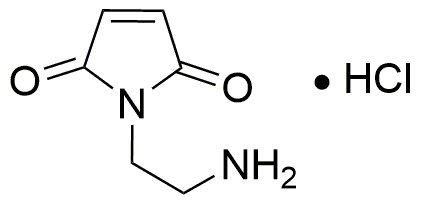N-(2-Aminoethyl)maleimide hydrochloride is widely utilized in research focused on:
- Bioconjugation: This compound is commonly used to attach biomolecules, such as proteins or antibodies, to surfaces or other molecules, enhancing the development of targeted drug delivery systems.
- Diagnostics: It plays a crucial role in the creation of diagnostic assays, particularly in the detection of specific proteins or biomarkers in medical testing.
- Polymer Chemistry: In the field of materials science, it is used to modify polymers, improving their properties for applications in coatings, adhesives, and sealants.
- Cell Biology: Researchers utilize this compound to study cell signaling pathways and interactions, providing insights into cellular functions and disease mechanisms.
- Therapeutic Development: It is being explored for its potential in developing new therapeutic agents, particularly in cancer treatment, due to its ability to selectively target and modify cellular components.
Información general
Propiedades
Seguridad y normativas
Aplicaciones
N-(2-Aminoethyl)maleimide hydrochloride is widely utilized in research focused on:
- Bioconjugation: This compound is commonly used to attach biomolecules, such as proteins or antibodies, to surfaces or other molecules, enhancing the development of targeted drug delivery systems.
- Diagnostics: It plays a crucial role in the creation of diagnostic assays, particularly in the detection of specific proteins or biomarkers in medical testing.
- Polymer Chemistry: In the field of materials science, it is used to modify polymers, improving their properties for applications in coatings, adhesives, and sealants.
- Cell Biology: Researchers utilize this compound to study cell signaling pathways and interactions, providing insights into cellular functions and disease mechanisms.
- Therapeutic Development: It is being explored for its potential in developing new therapeutic agents, particularly in cancer treatment, due to its ability to selectively target and modify cellular components.
Documentos
Hojas de datos de seguridad (HDS)
La SDS proporciona información de seguridad completa sobre la manipulación, el almacenamiento y la eliminación del producto.
Especificación del producto (PS)
La PS proporciona un desglose completo de las propiedades del producto, incluida la composición química, el estado físico, la pureza y los requisitos de almacenamiento. También detalla los rangos de calidad aceptables y las aplicaciones previstas del producto.
Certificados de análisis (COA)
Busque certificados de análisis (COA) ingresando el número de lote del producto. Los números de lote y de partida se pueden encontrar en la etiqueta de un producto después de las palabras "Lote" o "Lote".
Número de catálogo
Número de lote/lote
Certificados de origen (COO)
Este certificado de origen confirma el país en el que se fabricó el producto y también detalla los materiales y componentes utilizados en él y si se deriva de fuentes naturales, sintéticas u otras fuentes específicas. Este certificado puede ser necesario para cumplir con las normativas aduaneras, comerciales y regulatorias.
Número de catálogo
Número de lote/lote
Hojas de datos de seguridad (HDS)
La SDS proporciona información de seguridad completa sobre la manipulación, el almacenamiento y la eliminación del producto.
DownloadEspecificación del producto (PS)
La PS proporciona un desglose completo de las propiedades del producto, incluida la composición química, el estado físico, la pureza y los requisitos de almacenamiento. También detalla los rangos de calidad aceptables y las aplicaciones previstas del producto.
DownloadCertificados de análisis (COA)
Busque certificados de análisis (COA) ingresando el número de lote del producto. Los números de lote y de partida se pueden encontrar en la etiqueta de un producto después de las palabras "Lote" o "Lote".
Número de catálogo
Número de lote/lote
Certificados de origen (COO)
Este certificado de origen confirma el país en el que se fabricó el producto y también detalla los materiales y componentes utilizados en él y si se deriva de fuentes naturales, sintéticas u otras fuentes específicas. Este certificado puede ser necesario para cumplir con las normativas aduaneras, comerciales y regulatorias.


